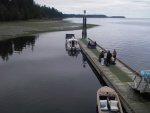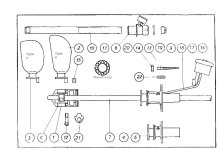I thought I'd start a thread on the "interesting" methods you see used by others while docking. While out at Neah Bay this past week, I saw one method in particular that cracked me up. A SeaSport just down the dock from me likes to dock stern first. He has a line attached to the port side stern cleat (not midships). One of his fishing buddies holds this line in his hand a the captain approaches the dock. The captain turns away from the dock to line up the stern to the slip. Once he's slow and fairly parallel to the dock, he guns it in reverse. Now he's going several kts backwards and the buddy in the back readies himself to jump off. Just prior to hitting the end of the slip, the captain switches from reverse to forward and guns it again to prevent the boat from hitting the dock. At that magical transition time between going fast in reverse and fast in forward, his buddy leaps off the boat and attaches the line as fast as he can. The forward motion of the boat pulls it into the dock. However, depending on which dock cleat was used and how much line is left over, the bow of the boat may wind up several feet beyond the end of the dock. They then pull the boat back in by hand and eventually tie it up.
The funniest part was once when the buddy couldn't get it tied up fast enough. He did a belly flop back into the boat so they could get a second shot at the "procedure". We had fun watching them every time they came in as nearly every docking was a bit of an adventure. What's the most interesting procedure you have witnessed?
The funniest part was once when the buddy couldn't get it tied up fast enough. He did a belly flop back into the boat so they could get a second shot at the "procedure". We had fun watching them every time they came in as nearly every docking was a bit of an adventure. What's the most interesting procedure you have witnessed?




